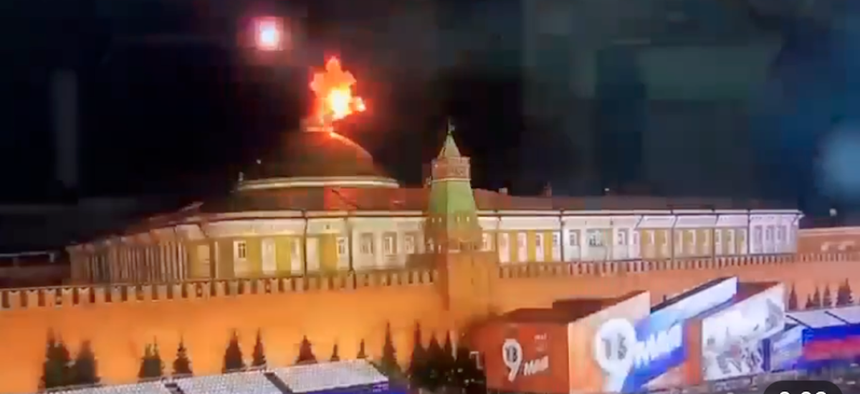
A screenshot of a video posted to the Telegram messaging service purports to show a drone exploding over the Kremlin in the early hours of May 3, 2023. TELEGRAM
Who Bombed the Kremlin?
U.S. officials puzzle over what appears to be the first drone attack on Moscow.
An early-Wednesday drone attack on the Kremlin has Moscow accusing Ukraine of a raid on the Russian capital—but U.S. officials aren’t so sure.
A video shared to social media network Telegram shows a slim gray tube gliding through the night past a Russian flag atop a Kremlin building, then exploding just overhead. A second drone is visible in other photos distributed online, matching Russian official accounts of an attack by two drones.
If it were a Ukrainian operation, it would be Kviv’s first known attack on Moscow since Russia invaded in February 2022, and would mark a symbolic escalation of the war as a Ukrainian counter-offensive looms and Russia accelerates a draft to replace heavy losses.
But that’s far from clear. Russian officials said, without evidence, that the objective was to assassinate Russian President Vladimir Putin as he slept.
Responded U.S. Secretary of State Anthony Blinken at an event Wednesday: “I would take anything out of the Kremlin with a very large shaker of salt.”
The attack came just days before Russians are to flood into Moscow’s streets for the annual May 9 celebration of victory in World War II. Putin has leaned heavily on WWII metaphors to justify his invasion—saying, for example, that Germany’s donation of Leopard tanks to Ukraine echoed the Nazi attack on the Soviet Union.
Ukraine has denied responsibility. “We don’t attack Putin or Moscow; we fight on our territory,” President Volodymr Zelenskyy said during a state visit to Finland.
But Wednesday’s explosion followed other strikes on Russian bases, some—like Moscow—hundreds of miles inside Russian territory. Some reports have quoted anonymous Ukrainians as saying they used modified Soviet-era Tu-141 surveillance aircraft in the earlier attacks, even as officials denied involvement.
In any case, Ukraine has so far held off from attacking symbolically potent targets within Russia, even as Russian missiles and drones devastate the urban cores of Ukrainian cities far from the front line.
To John Herbst, a former U.S. ambassador to Ukraine, this forbearance suggests that the video is a Russian false-flag operation.
If so, said Katie Sendak of the CEPA think tank, its goal could be to try to “garner national support ahead of loss numbers and another potential mobilization.”
A U.S. official said Washington is working to establish just what occurred.
“We are looking into the report but aren’t able to confirm it or validate its authenticity,” the official said. “We have said throughout the conflict that we do not encourage or enable Ukraine to strike within Russia.”
The drone pictured in the strike did not appear to be the large Tu-141 reportedly used in previous Ukrainian attacks. The likely payload on such a small drone calls into question the Kremlin’s claim that Putin was the target, said CNA analyst Sam Bendett.
Such a payload “can cause damage against vulnerable sites like energy infrastructure,” but would not be sufficient for an assassination attempt against Putin, Bendett said.
Putin, a former KGB officer, takes his security seriously. For domestic trips, the Russian leader often eschews air travel for an armored train that makes secret stops, according to Russian investigative outlet Proekt.
Herbst called into question the idea that Putin would even be in the Kremlin at night, noting that Putin more commonly sleeps in his compound at Novo-Ogaryovo outside Moscow. The Russian president maintains numerous residences across Russia, including a sprawling palace built in the south, according to anti-corruption advocate and jailed Russian politician Alexei Navalny.
Moscow’s air defenses are designed to defeat cruise and ballistic missiles, not drones, said Dara Massicot, a senior policy researcher at RAND. The drone seen in the video may have been hit by point-defense systems, like the Pantsir missile system, recently installed at key points in central Moscow, Massicot said.




